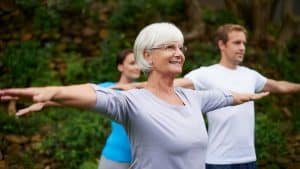
For the last half year, when walking from the parking lot to my office building, I would hop on a curb alongside a lawn and walk it as if it were a balance beam. It does look weird and gets me a fair share of puzzled glances. But I persist. Let me tell you why.
What Is Balance?
Balance is a key concept in medicine. We talk about balanced diet, work-life balance, and balanced emotions. But curiously, we don’t pay much attention to actual physical balance. That is, until a person falls and sustains an injury.
What started me on my curb-walking was a study linking three exercises (one-legged balance, grip strength, and squats) that correlated with longevity. Yes, longevity – the Holy Grail of medicine.
My Experiment
Naturally, I set out to test myself. Squats and grip strength turned out to be no problem. The balance exercise sounded really simple, so I left it for the very end.
In the study, the researchers had the subjects stand on one leg with eyes closed and measured the time it took until their balance broke. Anything below 5 seconds was abnormal. No problem, I thought.
Boy, was I wrong. No matter what I did, I could not keep my balance. As soon I as closed my eyes, I would sway like a hurricane-battered palm tree.
Five seconds was out of the question on the first attempt. And the second. And third. It was beyond embarrassing. Normally, I prided myself on a rather good sense of balance. So, what was happening? And what did it say about my ability to live longer?
Balance Exercises
Terrified, I added balance exercises to my routine, and I am happy to report that things have improved significantly since.
But let me ask you: When was the last time you did any balance exercises?
In truth, unless we work with a good personal trainer, or have some specific reason to focus on balance, like a previous fall (or reading a scary research article), we usually don’t pay balance any special attention.
Too bad, because the benefits of balance training are many.
What Are the Benefits?
It goes without saying: balance training decreases your risk of falling. You may think it is no big deal, unless, of course, you did fall in the past and understand the consequences first hand.
Aside from the obvious ones, like suffering a contusion, or even a fracture, which can put one out of commission for several months, great many people develop fear of falling. It doesn’t sound like much, but believe me, it is.
Like a subtle static in the background, not easily noticed at first, it may run in the back of your head, unconsciously preventing you from exercising, walking outside and generally enjoying activities you gave no second thought before.
Beyond that, balance training tones and increases the strength in your thighs, hips, and core muscles. When your body micro-corrects your posture and position of your legs, trunk, and arms to maintain its balance, it activates these muscles and adds to the toning effect.
Balance exercises are great for joint stabilization, coordination, and developing body awareness. They help with agility, that is, your ability to move efficiently and gracefully. Not to mention injury prevention.
Good Balance Correlates with Longevity
This seems obvious, you may say. If you don’t fall, you don’t injure yourself. So, less injuries mean longer life. That reasoning would be right. However, the longevity effect seems to work independently, not directly correlating to prevention from fall injuries.
The study I mentioned above showed an improved sense of balance in Japanese elders, which seemed to have prevented all kinds of different causes of mortality, with the exception of cancer.
Don’t forget to check out our FREE gentle yoga videos on YouTube.
Of course, as scientists like to point out, just because two things correlate does not mean that one of them causes the other. So, I cannot tell you with 100% certainty that improving balance causes people to live longer. But it certainly raises lots of interesting possibilities.
Meanwhile, I plan to keep walking the curbs and otherwise work on my balance. I would suggest you do the same. The American College of Sports Medicine recommends doing balance exercises at least three times a week.
The Balance Enhancement Exercise Program (BEEP)
Perhaps you are already doing Yoga and Tai Chi, both being fantastic balance enhancers. But, if you’d like to try something more focused that you can do on the go, try the BEEP – Balance Enhancement Exercise Program – designed by scientists from Lund University in Sweden.
Warm up beforehand by dancing to your favorite song or jogging in place for 3 minutes. BEEP contains three exercises:
Knee Squats
Keep your knees shoulder width apart, hands on the hips, eyes open. Imagine that you are sitting down on a chair. Go as deep as you can, but no deeper than until your thighs are parallel to the floor. Straighten your legs again. Repeat 10 times.
Heel/Calf Raises
Stand with arms crossed over your chest, eyes open. Raise your heels and come up on your toes. Hold for as long as you can, up to 10 seconds. Come down. Repeat 3 times, 5 seconds apart.
One-Legged Stance
With your hands on your hips, pick up one leg 6–7 inches from the floor. Fix your eyes on a point about six feet away. Do it for as long as you can or up to 1 minute. Repeat with the other leg.
You may add a degree of difficulty by doing the exercises on a soft, compliant surface, such as a yoga or exercise mat folded in two. After you feel proficient with the exercises, you may give them a try with closed eyes.
Let’s Have a Conversation:
Have you tried your balance lately? Are you able to stand on one leg for over five seconds? How else have you been working on your balance? Please join the conversation below.





